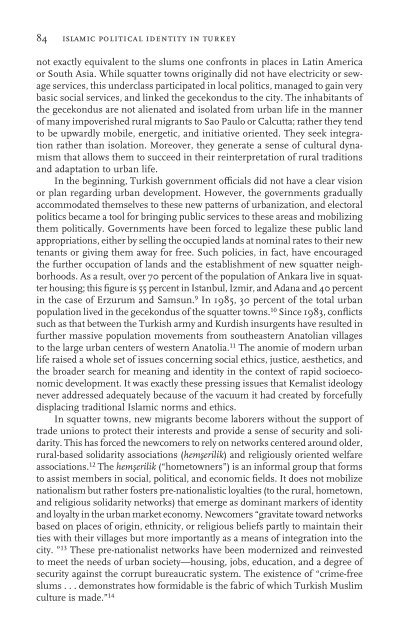You also want an ePaper? Increase the reach of your titles
YUMPU automatically turns print PDFs into web optimized ePapers that Google loves.
84 islamic political identity <strong>in</strong> turkeynot exactly equivalent to the slums one confronts <strong>in</strong> places <strong>in</strong> Lat<strong>in</strong> Americaor South Asia. While squatter towns orig<strong>in</strong>ally did not have electricity or sewageservices, this underclass participated <strong>in</strong> local politics, managed to ga<strong>in</strong> verybasic social services, and l<strong>in</strong>ked the gecekondus to the city. The <strong>in</strong>habitants ofthe gecekondus are not alienated and isolated from urban life <strong>in</strong> the mannerof many impoverished rural migrants to Sao Paulo or Calcutta; rather they tendto be upwardly mobile, energetic, and <strong>in</strong>itiative oriented. They seek <strong>in</strong>tegrationrather than isolation. Moreover, they generate a sense of cultural dynamismthat allows them to succeed <strong>in</strong> their re<strong>in</strong>terpretation of rural traditionsand adaptation to urban life.In the beg<strong>in</strong>n<strong>in</strong>g, Turkish government oYcials did not have a clear visionor plan regard<strong>in</strong>g urban development. However, the governments graduallyaccommodated themselves to these new patterns of urbanization, and electoralpolitics became a tool for br<strong>in</strong>g<strong>in</strong>g public services to these areas and mobiliz<strong>in</strong>gthem politically. Governments have been forced to legalize these public landappropriations, either by sell<strong>in</strong>g the occupied lands at nom<strong>in</strong>al rates to their newtenants or giv<strong>in</strong>g them away for free. Such policies, <strong>in</strong> fact, have encouragedthe further occupation of lands and the establishment of new squatter neighborhoods.As a result, over 70 percent of the population of Ankara live <strong>in</strong> squatterhous<strong>in</strong>g; this Wgure is 55 percent <strong>in</strong> Istanbul, Izmir, and Adana and 40 percent<strong>in</strong> the case of Erzurum and Samsun. 9 In 1985, 30 percent of the total urbanpopulation lived <strong>in</strong> the gecekondus of the squatter towns. 10 S<strong>in</strong>ce 1983, conXictssuch as that between the Turkish army and Kurdish <strong>in</strong>surgents have resulted <strong>in</strong>further massive population movements from southeastern Anatolian villagesto the large urban centers of western Anatolia. 11 The anomie of modern urbanlife raised a whole set of issues concern<strong>in</strong>g social ethics, justice, aesthetics, andthe broader search for mean<strong>in</strong>g and identity <strong>in</strong> the context of rapid socioeconomicdevelopment. It was exactly these press<strong>in</strong>g issues that Kemalist ideologynever addressed adequately because of the vacuum it had created by forcefullydisplac<strong>in</strong>g traditional <strong>Islamic</strong> norms and ethics.In squatter towns, new migrants become laborers without the support oftrade unions to protect their <strong>in</strong>terests and provide a sense of security and solidarity.This has forced the newcomers to rely on networks centered around older,rural-based solidarity associations (hem7erilik) and religiously oriented welfareassociations. 12 The hem7erilik (“hometowners”) is an <strong>in</strong>formal group that formsto assist members <strong>in</strong> social, political, and economic Welds. It does not mobilizenationalism but rather fosters pre-nationalistic loyalties (to the rural, hometown,and religious solidarity networks) that emerge as dom<strong>in</strong>ant markers of identityand loyalty <strong>in</strong> the urban market economy. Newcomers “gravitate toward networksbased on places of orig<strong>in</strong>, ethnicity, or religious beliefs partly to ma<strong>in</strong>ta<strong>in</strong> theirties with their villages but more importantly as a means of <strong>in</strong>tegration <strong>in</strong>to thecity. ” 13 These pre-nationalist networks have been modernized and re<strong>in</strong>vestedto meet the needs of urban society—hous<strong>in</strong>g, jobs, education, and a degree ofsecurity aga<strong>in</strong>st the corrupt bureaucratic system. The existence of “crime-freeslums . . . demonstrates how formidable is the fabric of which Turkish Muslimculture is made.” 14




